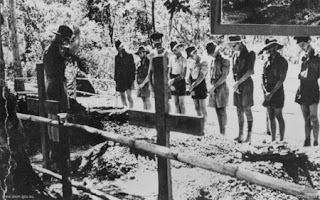 |
| My father passed away on September 18,1943 building the infamous railway line as a Japanese POW. |
Everywhere in the jungle the grave-yards made their appearance. When the railway was completed at the end of October 1943, thousands of bodies lay in the jungle from one end of the railway to the other. My father was one of them. His friends had laid him to rest in Kuie, a small graveyard site, beside the railroad tracks.He died of total exhaustion,dehydration and starvation. A fellow prisoner Mr. Veenstra, told my mother about his last days.Mr. Veenstra was one of the lucky ones to survive this ordeal.
The prisoners lived their captivity as an endless nightmare and with no hope. Many died of despair. The fortunate to awaken from their ordeal were never the same again. The nightmares returned to haunt their sleep and the faces of those left behind have never left them.
We will never feel the pain they endured and fortunately we can awaken from the despair,that despair that became their living hell as Japanese POW's.
 |
| They made it, the war was over, but their nightmares began. |
The Japanese seemed to have one thought here; if you are not working you are dying. Their one thought was the railway. It had to be built; nothing was to stand in the way. There were plenty prisoners.
It was shocking what happened there in the jungle on that railway. The monsoons had started and everywhere was mud; the huts were falling to pieces full of bugs, and all prisoners Dutch, English, Australians, looked dreadful. There they were slipping and sliding down the muddy track.
There was a smell of decay in the whole camp of stagnation. The camp hospital was another miserable hut, falling to pieces and inside lay the remnants of what once were fine young men, dying in loathsome squalor. The stench of bed-pans, the groans of the men with malaria, the dirty smell of sweaty clothing, the lice and the smell of bug infested bamboo-beds filled the air. The Japs had only one thought and that was the railway. Nothing would stand in their way.
I came upon this poem written by Margaret Puffett, she visited the Tamarkan Bridge, on the River Kwai. Her father died as a POW working on the rail road line, and I hope she does not mind I post her poem here on my blog. This is for all the dads who did not make it back home.Never to be forgotten.
Visit to Tarmakan Bridge;
by Margaret Puffett.
I stood beside the rail-way tracks where so many had to die.
Beaten, starved, their spirits unbroken they worked from morn to night,
To build the Burma rail-way stretching on and out of sight.
The River Kwai flows silent now, its waters still and deep,
It saw it all but never tells the secrets that it keeps.
Across the Bridge beneath a tree I laid a tiny cross,
A small but loving token to commemorate my loss.
And in silence and serenity,I said my Prayer to God,
Was I standing on the spot where my father once had trod?
The men long gone, the rail-way tracks and bridge in memory stand,
A memorial to those who died in protection of our land.
They died to give us freedom, through the trouble, war and strife
And paid the greatest price of all, the sacrifice of LIFE!
A daughter visits the bridge on the River Kwai
"The memory# of that trip will stay with me forever!
The Bridge, the River and the Rail-way- so peaceful now,
It's hard to believe what went on here.
But to be able to lay flowers at the Railway and at the cemetery,
I felt Dad knew we still loved him, and never forgotten him.
 |
| The rail way at the River Kwai. |
 |
| Kanchanaburi, Thailand |
 |
| Kanchanaburi, the Cemetery. Rest in Peace. |









Just to say that margaret puffett is my mum and she is very pleased that you have included her poem in your blog
ReplyDeleteI am so glad she did not mind. I was very touched by her poem.Give her my regards., and thanks for sharing. Thea
ReplyDelete